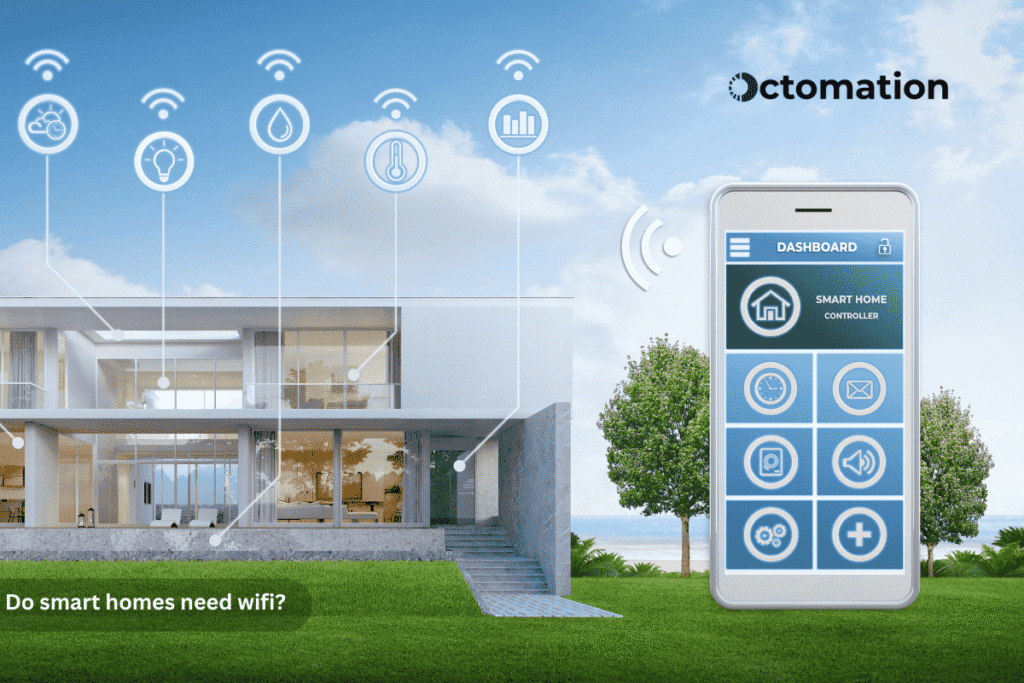How Does a Smart Home Work in the Connected World of Today?
A smart home has sophisticated automation technologies that give its occupants more control over the smart climate control, appliances, entertainment systems, lighting automation, and security. These gadgets are linked together by a central network, which is frequently controlled by hubs, voice assistants, or smartphones. This section presents the idea of “smart homes,” outlining its functions, the variety of technologies used, and the growing need for intelligent living spaces.
WiFi Crucial Function in Facilitating Smart Home Automation
For most smart home configurations, WiFi is the main communication link. It allows users to operate equipment remotely, receive updates, and synchronize automated processes by connecting devices to cloud services and each other. This section details how WiFi makes it easier for devices to communicate with one another, integrate mobile apps, and use voice assistants—all essential for a fully working smart home.
Which Smart Home Appliances Require WiFi Access?
WiFi is a major component of many of the most widely used and important smart home appliances. These include voice-activated speakers, robot vacuums, smart plugs, smart TVs, security cameras, video doorbells, and smart thermostats. This section describes the kinds of devices that need continuous or sporadic WiFi access and the reasons why real-time control, updates, and automation depend on this connectivity.
Is WiFi Necessary for Smart Home Operations? Examining Alternatives Offline
Despite WiFi’s dominance in smart home automation, several devices can operate without it, utilizing local communication methods. This section examines the limited offline control provided by some systems, such as those based on Bluetooth, Z-Wave, or Zigbee. It also discusses situations in which a home automation can operate in part without WiFi, including simple lighting controls or mesh networks for local device communication.
Which Is Better for Smart Homes: WiFi or Z-Wave, Thread, Bluetooth, or Zigbee?
Not every home automation company in INDIA appliance has WiFi. Other communication protocols, such as Bluetooth, Z-Wave, Thread, and Zigbee, provide better local mesh networking, less congestion, and lower power consumption. This section compares different technologies with WiFi to assist homeowners in selecting the protocol that best suits their smart ecosystem, examining their advantages, applications, and compatibility.
To experience seamless smart climate control, a stable WiFi connection is essential for syncing thermostats, sensors, and automation systems efficiently.
The Performance of Smart Homes Depends on a Robust and Stable WiFi Network
Even the most sophisticated smart home appliances work poorly without a dependable WiFi connection. This section explains the impact of network strength, bandwidth, router location, and signal interference on smart device efficiency and provides advice on how to set up your WiFi network to accommodate dozens of linked devices operating at once.

When WiFi fails, what happens to smart devices?
WiFi disruptions might result in limited functionality, interrupted automation, and inaccessible remote controls. This section describes what to anticipate during WiFi outages, which devices may continue to function locally, and which ones lose control. It also provides advice on how to fix issues and prepare your smart home for a brief outage of connectivity.
Smart Home Hubs: Connecting WiFi-Enabled and Non-WiFi Devices
Smart hubs, such as Apple HomePod, Samsung SmartThings, Google Nest Hub, and Amazon Echo, frequently serve as conduits between users and their gadgets. Even without WiFi, some hubs provide some degree of control via Thread or Zigbee. This section describes the operation of hubs, their function in WiFi-based vs. local control, and their applicability in hybrid smart home settings.
How to Make Your WiFi Network Better for a Smarter, More Effective Home
Optimizing the WiFi network is essential to maintaining a smart home’s functionality. This section offers practical guidance on mesh networks, WiFi extenders, router positioning, dual-band routers (2.4GHz vs. 5GHz), and device priority. It’s a useful manual for boosting signal strength, cutting down on latency, and avoiding device dropouts.
A reliable WiFi network is vital for a luxury home cinema design, ensuring smooth streaming, automation, and voice control integration. Ask ChatGPT
Conclusion: Is WiFi Necessary for Smart Homes to Function Well?
This final portion summarizes the entire conversation and confirms that even though there are some offline choices, WiFi is still necessary for complete operation, particularly for cloud-dependent automation, remote access, and security monitoring. It assists readers in making well-informed choices regarding the installation or enhancement of their smart home’s WiFi infrastructure.
The Future of Smart Homes: Transitioning from WiFi to Smooth Connectivity
SAs technology advances, smarthomes are starting to accept several protocols combining WiFi, Zigbee, Thread, and even cellular (like 5G) to create more robust and responsive systems. This section covers the emergence of theMatter protocol, the future of smart home Solutions technology, and what homeowners can anticipate in terms of automation and connectivity
Check Out Blogs of Smart Home’s
How to Automate Lights at Home?